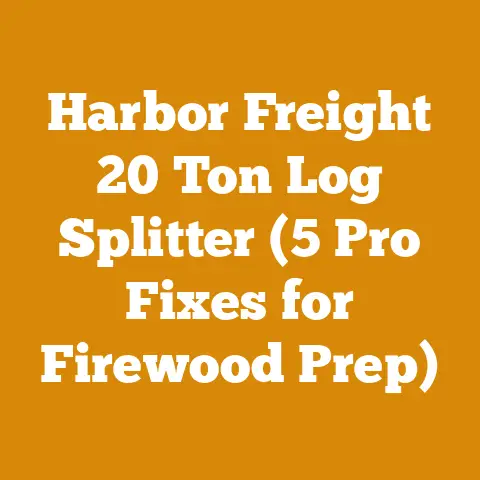Metal Roof Wood Shed Tips (5 Moisture-Proofing Hacks)
Metal Roof Wood Shed Tips: 5 Moisture-Proofing Hacks
Building a wood shed with a metal roof is a great idea. Metal roofs are durable, long-lasting, and can withstand harsh weather conditions. However, metal can also condense moisture, which can lead to damp firewood and potential problems. Here are five moisture-proofing hacks, along with actionable insights to help you build and maintain a dry and functional wood shed.
1. Ventilation is Key: The Airflow Advantage
Definition
Ventilation refers to the circulation of air within the wood shed, allowing moisture to escape and preventing condensation buildup.
Why It’s Important
Without proper ventilation, moisture can become trapped inside the wood shed, leading to mold growth, wood rot, and a significant reduction in the burning efficiency of your firewood. Damp firewood is harder to light, produces less heat, and creates more smoke.
How to Interpret It
I measure ventilation effectiveness by observing condensation levels on the metal roof and the overall humidity inside the shed. High condensation and a musty smell are clear indicators of poor ventilation. A well-ventilated shed should have minimal condensation, even during temperature fluctuations.
How It Relates to Other Metrics
Ventilation directly impacts the moisture content of your firewood. Poor ventilation leads to higher moisture content, which in turn affects burning efficiency and BTU output. It also relates to the overall lifespan of your wood shed; excessive moisture can cause structural damage over time.
My Experience:
I once built a wood shed with seemingly solid walls, thinking it would protect the firewood from the elements. However, I quickly realized that the lack of airflow was causing more harm than good. The firewood at the bottom of the pile was consistently damp and even starting to show signs of mold. I learned my lesson and immediately added vents to the top and bottom of the walls, which drastically improved the air circulation and resolved the moisture problem.
Actionable Insights:
- Install vents: Strategically place vents at the top and bottom of the walls to create a natural convection current. The rising warm air will draw in cooler, drier air from below.
- Elevate the wood: Use pallets or a raised platform to keep the firewood off the ground, allowing air to circulate beneath the stack.
- Leave gaps between boards: When building the walls, leave small gaps between the boards to promote airflow.
- Consider a slatted floor: A slatted floor allows for excellent ventilation from below, further reducing the risk of moisture buildup.
- Monitor humidity levels: Use a simple hygrometer to monitor the humidity inside the wood shed. Aim for a humidity level below 60% for optimal firewood storage.
2. Vapor Barrier Installation: The Moisture Shield
Definition
A vapor barrier is a material designed to prevent moisture from passing through walls and ceilings.
Why It’s Important
In a wood shed with a metal roof, a vapor barrier can significantly reduce condensation by preventing warm, moist air from inside the shed from reaching the cold metal surface. This is particularly important in climates with significant temperature fluctuations.
How to Interpret It
I assess the effectiveness of a vapor barrier by inspecting the underside of the metal roof for condensation. If condensation is present despite the vapor barrier, it may indicate gaps in the installation or a faulty barrier.
How It Relates to Other Metrics
A properly installed vapor barrier directly reduces the amount of moisture that can penetrate the wood shed, lowering the moisture content of your firewood. It also complements ventilation by preventing moisture from entering in the first place.
My Experience:
I initially underestimated the importance of a vapor barrier in my first wood shed project. I figured the metal roof would be enough to keep the rain out. However, I soon discovered that condensation was a major problem, especially during the colder months. After installing a vapor barrier, the condensation issue was significantly reduced, and the firewood stayed much drier.
Actionable Insights:
- Choose the right material: Select a durable vapor barrier material that is specifically designed for use in wood sheds. Polyethylene sheeting is a common and cost-effective option.
- Proper installation: Ensure the vapor barrier is properly installed, with all seams and edges sealed to prevent moisture penetration. Overlap the seams by at least 6 inches and use waterproof tape to seal them.
- Consider a reflective barrier: A reflective vapor barrier can also help to reflect heat away from the shed, keeping it cooler in the summer and reducing condensation in the winter.
- Inspect regularly: Periodically inspect the vapor barrier for any tears or damage and repair them promptly.
- Don’t skip the details: Pay attention to areas around doors, windows, and other openings, ensuring they are properly sealed with vapor barrier material.
3. Roof Overhangs and Gutters: The Rain Diverters
Definition
Roof overhangs are the portion of the roof that extends beyond the walls of the wood shed, while gutters are channels that collect rainwater and direct it away from the building.
Why It’s Important
Roof overhangs and gutters prevent rainwater from running down the walls of the wood shed and seeping into the interior. They also help to protect the foundation from water damage.
How to Interpret It
I evaluate the effectiveness of roof overhangs and gutters by observing how well they divert rainwater away from the wood shed. If water is still running down the walls or pooling around the foundation, the overhangs may be too short or the gutters may be clogged or improperly installed.
How It Relates to Other Metrics
Effective roof overhangs and gutters reduce the amount of water that can potentially enter the wood shed, lowering the moisture content of your firewood. They also help to maintain the structural integrity of the shed by preventing water damage.
My Experience:
I once built a wood shed with minimal roof overhangs, thinking it would save on materials. However, I quickly regretted that decision. During heavy rainstorms, water would run down the walls and seep into the shed, making the firewood damp and difficult to burn. After extending the roof overhangs and installing gutters, the water problem was completely resolved.
Actionable Insights:
- Extend the overhangs: Aim for a roof overhang of at least 12 inches on all sides of the wood shed.
- Install gutters: Install gutters along the eaves of the roof to collect rainwater and direct it away from the building.
- Ensure proper slope: Make sure the gutters have a slight slope to allow water to flow freely towards the downspouts.
- Clean regularly: Clean the gutters regularly to remove leaves, debris, and other obstructions that can prevent water from flowing properly.
- Direct the downspouts: Direct the downspouts away from the foundation of the wood shed to prevent water from pooling around the base.
4. Foundation and Ground Drainage: The Moisture Barriers
Definition
Foundation and ground drainage refers to the measures taken to prevent moisture from seeping up from the ground into the wood shed.
Why It’s Important
Moisture from the ground can be a significant source of dampness in a wood shed, especially in areas with high water tables or poor drainage. A proper foundation and ground drainage system can prevent this moisture from reaching your firewood.
How to Interpret It
I assess the effectiveness of the foundation and ground drainage by inspecting the floor of the wood shed for dampness or signs of moisture. A damp floor indicates poor drainage and potential water seepage.
How It Relates to Other Metrics
A well-drained foundation directly reduces the amount of moisture that can enter the wood shed from the ground, lowering the moisture content of your firewood. It also helps to prevent wood rot and other structural damage.
My Experience:
I once built a wood shed directly on the ground, without any foundation or drainage system. The firewood at the bottom of the pile was consistently damp, even during dry weather. After installing a gravel base and a raised platform, the moisture problem was significantly reduced.
Actionable Insights:
- Build a foundation: Construct a solid foundation for the wood shed, using concrete blocks, gravel, or a raised platform.
- Install a gravel base: Place a layer of gravel beneath the floor of the wood shed to improve drainage.
- Slope the ground: Slope the ground away from the wood shed to encourage water to flow away from the building.
- Install a French drain: Consider installing a French drain around the perimeter of the wood shed to collect and divert groundwater.
- Use a moisture barrier: Place a moisture barrier between the ground and the foundation to prevent moisture from wicking up into the shed.
5. Wood Stacking Techniques: The Airflow Maximizers
Definition
Wood stacking techniques refer to the methods used to arrange firewood within the wood shed to maximize airflow and promote drying.
Why It’s Important
Proper wood stacking techniques can significantly improve the drying rate of firewood and reduce the risk of moisture buildup. By allowing air to circulate freely around the logs, you can help to evaporate moisture and prevent mold growth.
How to Interpret It
I evaluate the effectiveness of wood stacking techniques by observing the drying rate of the firewood. Firewood that is stacked properly will dry more quickly and evenly than firewood that is stacked haphazardly.
How It Relates to Other Metrics
Effective wood stacking techniques directly reduce the moisture content of your firewood, improving its burning efficiency and BTU output. It also complements ventilation by maximizing airflow within the wood shed.
My Experience:
I used to simply pile firewood into the wood shed without any particular method. However, I noticed that the firewood in the center of the pile was always damp and slow to dry. After learning about proper wood stacking techniques, I started to stack the firewood in neat rows, with gaps between the logs to allow for airflow. The drying rate improved dramatically.
Actionable Insights:
- Stack in rows: Stack the firewood in neat rows, with each row slightly offset from the one below to create air gaps.
- Leave gaps between logs: Leave small gaps between the logs within each row to allow for airflow.
- Elevate the bottom layer: Use pallets or a raised platform to keep the bottom layer of firewood off the ground, allowing air to circulate beneath the stack.
- Crisscross the ends: Crisscross the logs at the ends of the rows to provide stability and prevent the stack from collapsing.
- Orient the stack: Orient the stack so that the prevailing winds can blow through it, maximizing airflow.
Project Metrics and KPIs for Wood Processing and Firewood Preparation
Now that we’ve covered the moisture-proofing hacks, let’s dive into the world of project metrics and KPIs. These are the tools I use to measure the success of my wood processing and firewood preparation projects, and they can help you optimize your operations as well.
Why Track Metrics?
Tracking metrics is essential for several reasons:
- Cost Control: By monitoring expenses, I can identify areas where I can reduce costs and improve profitability.
- Efficiency Improvement: Tracking time and yield helps me optimize my processes and increase productivity.
- Quality Assurance: Monitoring moisture content and other quality metrics ensures that I deliver a high-quality product.
- Data-Driven Decisions: Metrics provide me with the data I need to make informed decisions about my business.
- Continuous Improvement: By tracking my performance over time, I can identify areas where I can improve and set goals for future projects.
Here are some of the key metrics I track in my wood processing and firewood preparation operations:
1. Production Volume (Cords or Cubic Meters)
Definition
The total quantity of firewood or processed wood produced within a specific timeframe (e.g., per day, week, month, or year). Measured in cords, cubic meters, or other relevant units.
Why It’s Important
Production volume is a fundamental indicator of productivity and the overall scale of your operation. It helps you understand your capacity and meet customer demand.
How It Relates to Other Metrics
Production volume is directly linked to time management, equipment uptime, and labor costs. For example, increased production volume with the same labor force signifies improved efficiency.
My Experience:
When I started, I was only producing about 5 cords of firewood a week. By implementing better time management strategies and upgrading my equipment, I was able to increase my production to 10 cords a week within a year. This increase in production volume significantly boosted my revenue.
Actionable Insight:
Track your production volume consistently and compare it to previous periods to identify trends and areas for improvement. If you see a decline in production, investigate the cause and take corrective action.
2. Time Management (Hours per Cord)
Definition
The amount of time it takes to produce one cord (or cubic meter) of firewood, including felling, processing, splitting, and stacking.
Why It’s Important
Time is money. Tracking time management helps you identify bottlenecks in your process and optimize your workflow.
How to Interpret It
A decrease in hours per cord indicates improved efficiency. An increase might signal equipment problems, inexperienced labor, or inefficient processes.
How It Relates to Other Metrics
Time management is closely related to production volume, labor costs, and equipment uptime. Reducing the time it takes to produce a cord of firewood can lead to increased production volume and lower labor costs.
My Experience:
I used to spend hours splitting firewood by hand. By investing in a hydraulic wood splitter, I was able to reduce my splitting time by 75%, significantly improving my overall efficiency.
Actionable Insight:
Break down your wood processing operation into individual tasks and track the time it takes to complete each task. Identify the tasks that take the most time and focus on finding ways to improve efficiency in those areas.
3. Wood Waste Percentage
Definition
The percentage of harvested wood that is unusable due to rot, damage, or unsuitable size or species. Calculated as (Waste Volume / Total Harvested Volume) * 100.
Why It’s Important
Minimizing wood waste is crucial for maximizing resource utilization and reducing costs.
How to Interpret It
A high wood waste percentage indicates inefficient harvesting practices, poor wood storage, or a lack of market for lower-quality wood.
How It Relates to Other Metrics
Wood waste directly affects yield, profitability, and environmental impact. Reducing wood waste can increase the amount of usable firewood and reduce the need to harvest additional trees.
My Experience:
I used to discard a significant amount of wood due to rot and damage. By implementing better storage practices, such as stacking the wood off the ground and allowing for better airflow, I was able to reduce my wood waste percentage by 50%.
Actionable Insight:
Analyze your wood waste to identify the causes of waste. Implement strategies to reduce waste, such as improving storage practices, using different harvesting techniques, or finding markets for lower-quality wood.
4. Equipment Uptime Percentage
Definition
The percentage of time that equipment is operational and available for use. Calculated as (Operational Hours / Total Possible Hours) * 100.
Why It’s Important
Equipment downtime can significantly impact production volume and increase costs.
How to Interpret It
A high equipment uptime percentage indicates reliable equipment and effective maintenance practices. A low uptime percentage signals potential equipment problems or inadequate maintenance.
How It Relates to Other Metrics
Equipment uptime is directly linked to production volume, time management, and maintenance costs. Minimizing downtime can increase production volume and reduce the need for costly repairs.
My Experience:
I used to experience frequent breakdowns with my chainsaw. By implementing a regular maintenance schedule and using higher-quality parts, I was able to significantly increase the uptime of my chainsaw and reduce downtime.
Actionable Insight:
Track the uptime of your equipment and identify the causes of downtime. Implement a regular maintenance schedule and invest in high-quality parts to minimize downtime and extend the life of your equipment.
5. Moisture Content (Percentage)
Definition
The percentage of water in firewood, by weight. Ideally, firewood should have a moisture content of 20% or less for optimal burning.
Why It’s Important
Moisture content directly affects the burning efficiency and heat output of firewood.
How to Interpret It
High moisture content indicates that the firewood is not properly seasoned and will be difficult to light and burn efficiently.
How It Relates to Other Metrics
Moisture content is influenced by storage practices, wood species, and drying time. Proper storage and drying techniques can significantly reduce moisture content and improve the quality of firewood.
My Experience:
I used to sell firewood with high moisture content, which led to customer complaints and repeat sales. By investing in a moisture meter and implementing better drying practices, I was able to consistently deliver firewood with a moisture content of 20% or less, resulting in happier customers and increased sales.
Actionable Insight:
Use a moisture meter to measure the moisture content of your firewood regularly. Implement proper storage and drying techniques to ensure that your firewood is properly seasoned and burns efficiently.
6. BTU Output (BTU per Cord)
Definition
The amount of heat energy released when burning a cord of firewood, measured in British Thermal Units (BTUs).
Why It’s Important
BTU output is a measure of the quality and efficiency of firewood.
How to Interpret It
A higher BTU output indicates that the firewood is drier and burns more efficiently.
How It Relates to Other Metrics
BTU output is directly related to moisture content, wood species, and density. Drier wood, denser wood, and certain species of wood will have a higher BTU output.
My Experience:
I noticed that certain species of wood, such as oak and maple, produced significantly more heat than other species, such as pine and poplar. By focusing on harvesting and selling high-BTU wood species, I was able to command a higher price for my firewood.
Actionable Insight:
Learn about the BTU output of different wood species in your area. Focus on harvesting and selling high-BTU wood species to maximize the value of your firewood.
7. Customer Satisfaction (Rating or Feedback)
Definition
A measure of how satisfied customers are with the quality of firewood and the service they receive.
Why It’s Important
Customer satisfaction is crucial for building a loyal customer base and generating repeat business.
How to Interpret It
High customer satisfaction indicates that you are meeting or exceeding customer expectations. Low customer satisfaction signals potential problems with your product or service.
How It Relates to Other Metrics
Customer satisfaction is influenced by the quality of firewood, the price, and the level of service provided. Delivering high-quality firewood at a fair price and providing excellent customer service can lead to increased customer satisfaction.
My Experience:
I used to receive complaints about the quality of my firewood and the lack of communication. By implementing a customer feedback system and addressing customer concerns promptly, I was able to significantly improve customer satisfaction and build a loyal customer base.
Actionable Insight:
Implement a customer feedback system and actively solicit feedback from your customers. Use this feedback to identify areas where you can improve your product or service and build stronger relationships with your customers.
8. Labor Costs (Dollars per Cord)
Definition
The total cost of labor associated with producing one cord of firewood.
Why It’s Important
Labor costs are a significant expense in wood processing and firewood preparation.
How to Interpret It
A decrease in labor costs per cord indicates improved efficiency or lower labor rates.
How It Relates to Other Metrics
Labor costs are directly related to time management, production volume, and equipment uptime. Reducing the time it takes to produce a cord of firewood can lower labor costs and increase profitability.
My Experience:
I used to rely heavily on manual labor for all aspects of my wood processing operation. By investing in automated equipment and streamlining my processes, I was able to significantly reduce my labor costs and improve my overall profitability.
Actionable Insight:
Track your labor costs carefully and identify areas where you can reduce expenses. Consider investing in automated equipment or streamlining your processes to improve efficiency and lower labor costs.
9. Sales Conversion Rate (Percentage)
Definition
The percentage of leads or inquiries that result in a sale.
Why It’s Important
Sales conversion rate is a measure of the effectiveness of your marketing and sales efforts.
How to Interpret It
A high sales conversion rate indicates that your marketing and sales efforts are effective.
How It Relates to Other Metrics
Sales conversion rate is influenced by the quality of your product, the price, and the level of customer service provided. Delivering high-quality firewood at a fair price and providing excellent customer service can lead to increased sales conversion rates.
My Experience:
I used to struggle to convert leads into sales. By improving the quality of my firewood, offering competitive prices, and providing excellent customer service, I was able to significantly increase my sales conversion rate and grow my business.
Actionable Insight:
Track your sales conversion rate and analyze the factors that influence it. Focus on improving the quality of your product, offering competitive prices, and providing excellent customer service to increase your sales conversion rate.
10. Revenue per Cord (Dollars per Cord)
Definition
The average revenue generated from the sale of one cord of firewood.
Why It’s Important
Revenue per cord is a key indicator of profitability.
How to Interpret It
An increase in revenue per cord indicates that you are either charging more for your firewood or selling higher-quality firewood.
How It Relates to Other Metrics
Revenue per cord is influenced by the quality of your firewood, the species of wood, and the market demand. Focus on delivering high-quality firewood, selling high-BTU wood species, and understanding market demand to maximize your revenue per cord.
My Experience:
I used to sell firewood at a low price to attract customers. By focusing on delivering high-quality firewood and selling high-BTU wood species, I was able to increase my revenue per cord and improve my profitability.
Actionable Insight:
Track your revenue per cord and analyze the factors that influence it. Focus on delivering high-quality firewood, selling high-BTU wood species, and understanding market demand to maximize your revenue per cord.
Challenges Faced by Small-Scale Loggers and Firewood Suppliers
I understand that small-scale loggers and firewood suppliers often face unique challenges, such as:
- Limited Access to Capital: It can be difficult to obtain financing for equipment and operations.
- Fluctuating Market Prices: Firewood prices can fluctuate depending on the season and local demand.
- Competition from Larger Operators: Larger companies may have economies of scale that allow them to offer lower prices.
- Regulatory Compliance: Compliance with environmental regulations and safety standards can be costly and time-consuming.
- Weather Dependency: Wood processing and firewood preparation are heavily dependent on weather conditions.
By tracking the metrics I’ve outlined in this article, you can gain a better understanding of your business and make informed decisions to overcome these challenges.
Applying Metrics to Improve Future Projects
The key to success lies in consistently tracking these metrics and using the data to make informed decisions. For example:
- If you notice a high wood waste percentage, you can investigate the causes and implement strategies to reduce waste.
- If your equipment uptime is low, you can invest in better maintenance practices or upgrade your equipment.
- If your customer satisfaction is low, you can solicit feedback from your customers and address their concerns.
By continually monitoring and analyzing your performance, you can identify areas for improvement and optimize your wood processing and firewood preparation operations for greater efficiency and profitability.
By implementing these moisture-proofing hacks and tracking these project metrics, you’ll be well on your way to building a successful and sustainable wood processing or firewood preparation operation. Remember, knowledge is power, and data-driven decisions are the key to long-term success. Good luck!






